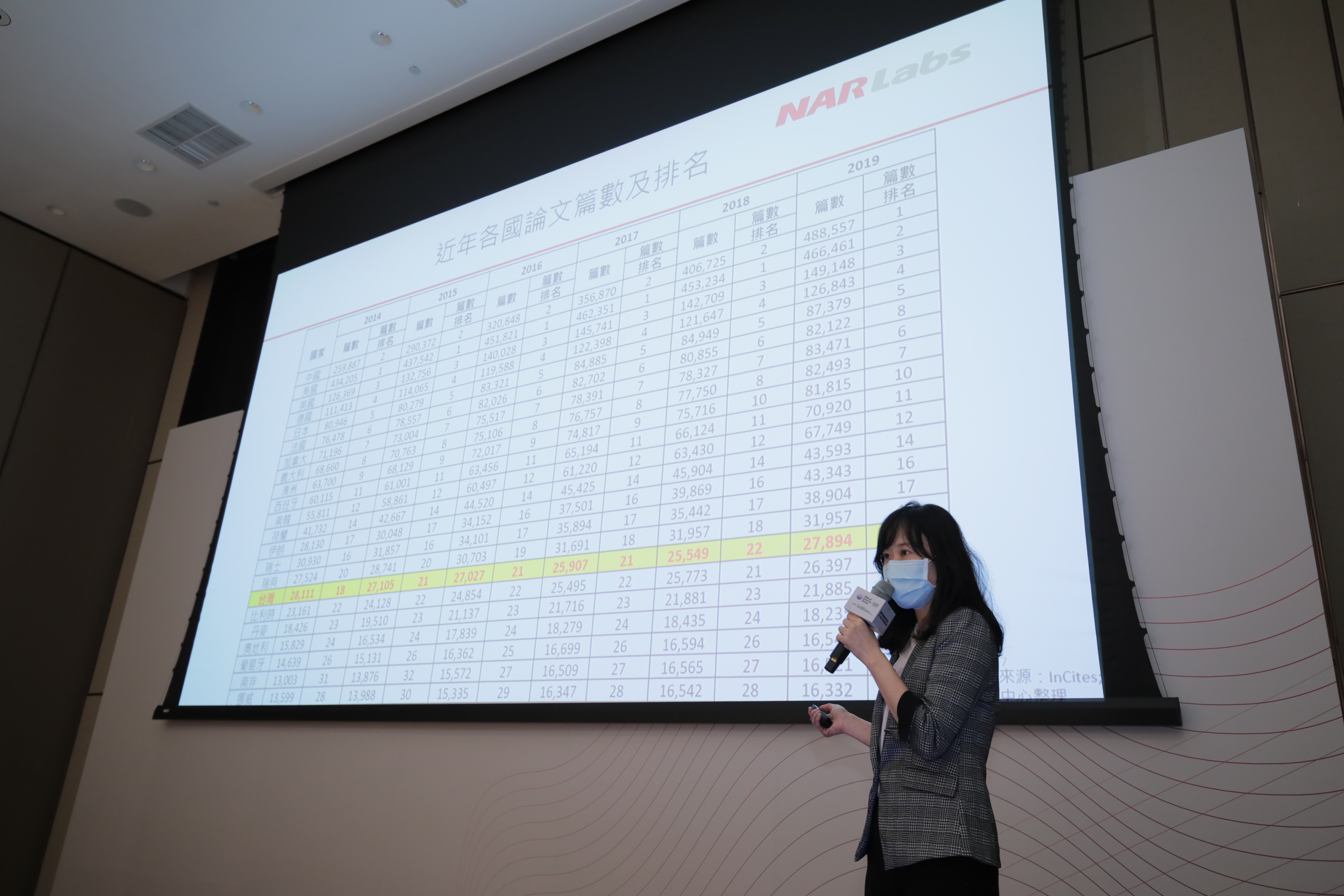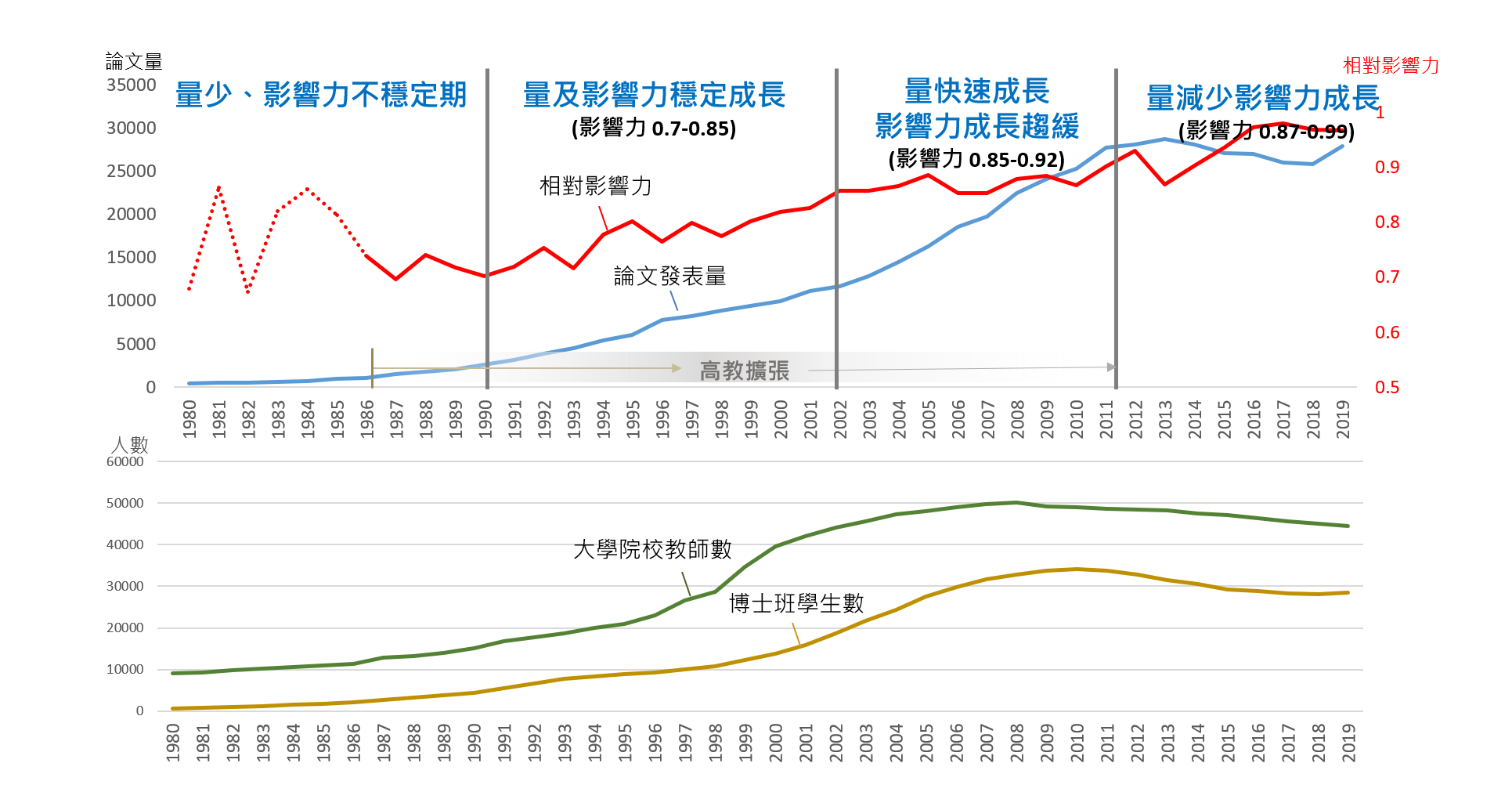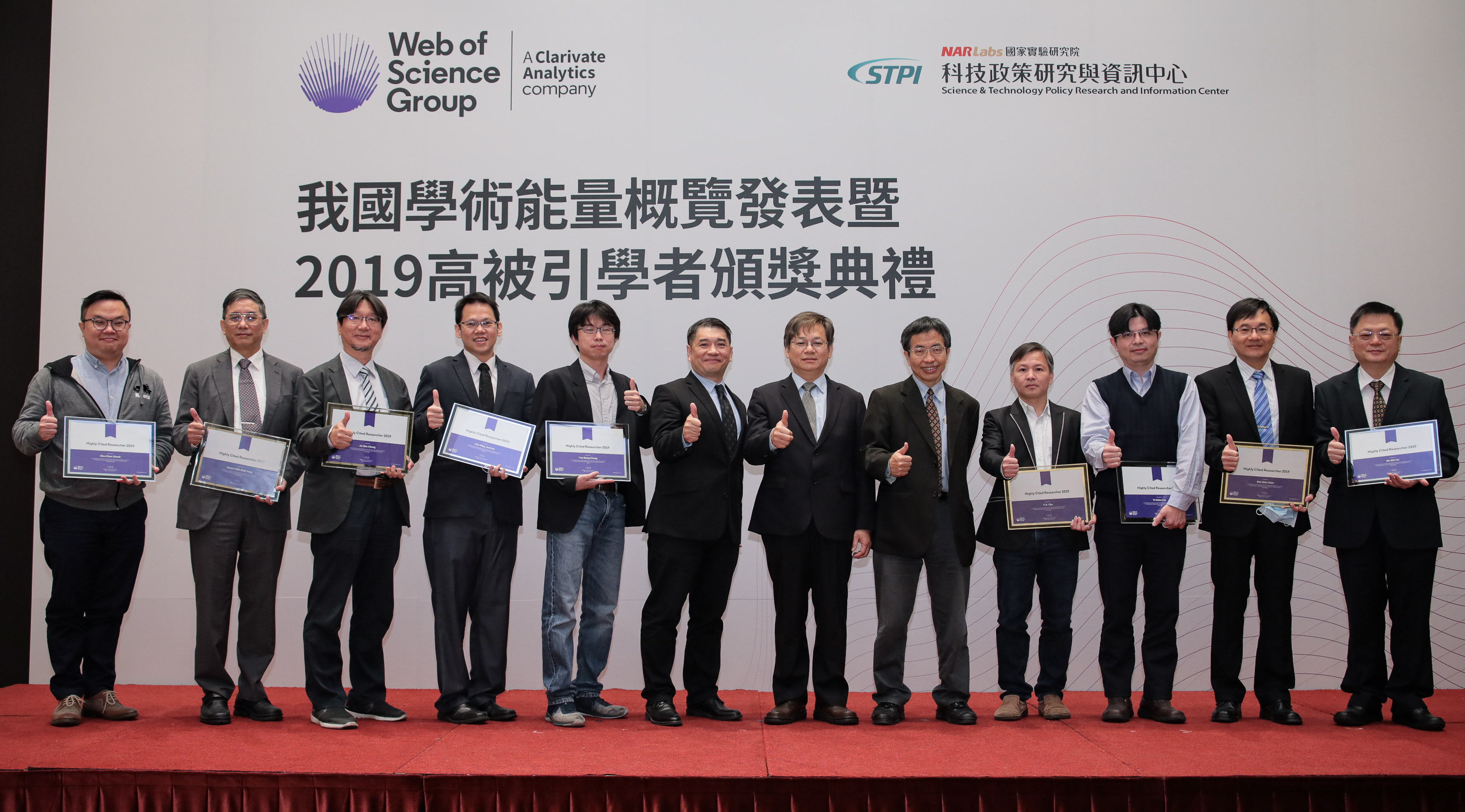|
According to a study by Science & Technology Policy Research and Information Center (STPI) of the National Applied Research Laboratories (NARLabs), Taiwan ranked 21st globally for the number of publications in 2019. Despite the drop from its record-high ranking of 16th, Taiwan's relative impact factor of papers has increased from 0.81 in 2000-2004 to 0.99 in 2015-2019. The proportion of the top 1% most cited papers has also increased from 0.53% in 2000–2004 to 1.05% in 2015–2019. The results show a gradual shift in Taiwan's research from quantity to quality and the growing academic influence of Taiwan among the leading countries. |
|
Academic research is the driver of innovative national capacity. Understanding Taiwan's research capacity helps provide a comprehensive picture of the national fundamental research development. Since most academic research results are published in international journals, both the number and impact of journal publications have become common criteria for research capacity assessment. With the criteria in mind, STPI has long observed and analyzed trends of paper publications in international journals from Taiwan and other benchmark countries. On April 28, STPI and Clarivate, a professional information service provider, cohosted the Presentation of National Research Capacity and Awards Ceremony for Highly Cited Researchers 2019. The event presented the study results on the current status and future trends of Taiwan's paper publication and celebrated the 17 scholars selected in Clarivate's annual list of Highly Cited Researchers. |
|
The study on research capacity analyzed the quality and quantity of Taiwan's paper publications in international journals based on data collected from the Web of Science databases (SCIE, SSCI, A&HCI, and CPCI). From a global perspective, the study also analyzed the performance of three categories of benchmark countries: traditional technology powerhouses (e.g., the US, the UK, Germany, France, and Canada), highly-innovative countries (e.g., Switzerland, Denmark, the Netherlands, Sweden, Australia, and Israel), and neighboring Asian countries (China, Japan, South Korea, and Singapore). |
|
|
| (Caption) STPI researcher Dr. Wen-Chi Hung presents the analysis of Taiwan’s research capacity |
|
Number of Publications |
|
STPI's observation of paper publications of different countries over the past two decades showed a year-by-year decrease in the number of Taiwan's paper publications in the Web of Science after its peak in 2012. A small rebound was seen in 2019. With 27,894 paper publications in 2019, Taiwan's global ranking dropped from the previous best of 16th to 21th in the same year. |
|
As for other countries, China has seen a huge surge, with the number of publications surpassing that of the US and topping the world. Japan's ranking has remained unchanged on the 5th since its drop from 3rd in 2000. Korea climbed up from 16th in 2000 to 12th. Israel has also witnessed a rather significant change in its rankings, with a gradual decrease over the years. |
|
Quality of Publications |
|
The analysis adopted two indicators regarding academic influence to evaluate the quality of publications, which are "relative impact" and "the proportion of top 1% most cited papers". The relative impact factor can represent a country's citation impact compared to the worldwide average. An impact factor of 1 indicates a country's leading status regarding academic influence. Among the top 30 countries with the most papers published, a total of 19 countries reach a relative impact factor of over one. Most of them are technologically advanced countries as well as highly innovative small countries, the former including the US, the UK, and Germany, while latter Switzerland and the Netherlands. |
|
Taiwan shows an increase in the relative impact factor of papers from 0.81 in 2000–2004 to 0.99 in 2015–2019, which is nearly comparable to that of the leading countries. Between 2015 and 2019, Switzerland, Denmark, and the Netherlands have the highest impact factors, and countries like Singapore, Australia, and China have seen significant growth of impact factor value. |
|
The proportion of the top 1% most highly cited papers is calculated by dividing the number of a country's top 1% most cited papers in each field each year with the total number of a country's paper publications in the same year. If a country's proportion of the top 1% most highly cited papers reaches 1%, it means the country has secured the leading status regarding the proportion of frontier research. |
|
Despite the decrease in the total number of paper publications, Taiwan’s number of top 1% most highly cited papers had increased from 315 in 2000-2004 to 1,358 in 2015-2019. In addition, the proportion of the top 1% most highly cited papers had increased from 0.53% in 2000-2004 to 1.05% in 2015-2019, making Taiwan one of the leading countries in academic research. |
|
Despite the decrease in the total number of paper publications, Taiwan’s number of top 1% most highly cited papers had increased from 315 in 2000-2004 to 1,358 in 2015-2019. In addition, the proportion of the top 1% most highly cited papers had increased from 0.53% in 2000-2004 to 1.05% in 2015-2019, making Taiwan one of the leading countries in academic research. |
|
As for other countries, Switzerland and the Netherlands have the highest proportion of the top 1% most highly cited papers, while Singapore, Australia, and China also see significant growth in the proportion in recent years. |
|
|
| (Caption) Proportions of the top 1% most cited papers of different countries |
|
International Collaboration in Paper Publication |
|
International collaboration has become a global trend of scientific research due to increasing research complexity and scale. In recent years, more countries, including Taiwan, have collaborated on paper publication. The proportion of Taiwan’s international collaborative papers had risen from 19% in 2000-2004 to 35.8% in 2015-2019. In 2019 alone, the number even increased to 41.1%. Highly innovative countries such as Switzerland, Singapore, Denmark, the Netherlands, and Sweden, had proportions close to or higher than 70%. |
|
International collaborative papers often enjoy greater visibility and higher impact. The relative impact factor of Taiwan’s collaborative papers between 2015 and 2019 was 1.49, which is significantly higher than that of their non-collaborative counterparts, which was 0.68. |
|
More researchers in Taiwan have joined the international collaboration in paper writing and worked with researchers with a more diverse background. Currently, Taiwan has the most international collaborative papers with the US, followed by China, Japan, and Germany. Although Taiwan had published over 2,000 international collaborative papers between 2005 and 2009, there were only three collaborative partners: the US, China, and Japan. The number of partners increased to 14 between 2015 and 2019. |
|
Long-term Trends in Number of Publications and Relative Influence of Taiwan |
|
Since 1980, Taiwan's paper publications have gone through three different phases: (1) low productivity and unsteady influence, (2) steadily growing productivity and influence, and (3) surging productivity with decelerating growth of influence. In recent years, the number of publications has declined due to criticism of the overemphasis on productivity and a decrease in the numbers of university teachers and Ph.D. students. Despite the lower number of publications, the focus on paper quantity has gradually shifted to quality when defining research capacity. With Taiwan's academic influence nearing that of the leading countries, the next step would be to apply research results to address challenges facing society and bring social impact. |
|
|
| (Caption) The number of publications and relative impact of Taiwan's papers over time; the numbers of university teachers and Ph.D. students during the same period |
|
One of STPI's missions is to assist decision-makers in building evidence-based policy-making models. In this regard, STPI has accumulated over 45 years' worth of knowledge and experience in providing value-added information as well as drafting S&T policy. Regular examinations of Taiwan's academic competitiveness enable STPI to assist in government decision-making with study results provided to relevant sectors. In so doing, STPI hopes to build a professional and comprehensive system of S&T policy-making in Taiwan. |
|
A record-breaking 17 scholars from Taiwan are on the list of Clarivate's Global Highly Cited Researchers 2019. The awards ceremony was held to congratulate the scholars. The list not only recognized the excellence and influence of Taiwanese researchers but also manifested the nation's research capacity in science and technology. |
|
|
|
(Caption) Group photo of the ceremony, from left to right: Chu-Chen Chueh, Assistant Professor at National Taiwan University; Chih-Hsin Yang, Professor at National Taiwan University; Jo-Shu Chang, Chair Professor at National Cheng Kung University; Hu, Che-Ming, Associate Research Fellow at Academia Sinica; Chang, Tay-Rong, Associate Professor at National Cheng Kung University; Nathan Fan, General Manager of Clarivate Taiwan; Yeong-Her Wang, President of NARLabs; Yuh-Jzer Joung, Director General of STPI; Ying-Hao Chu, Distinguished Professor at National Chiao Tung University; Yi-Hsien Lee, Professor at National Tsing Hua University; Wei-Hsin Chen, Professor at National Cheng Kung University; Liu, Ru-Shi, Distinguished Professor at National Taiwan University. |




